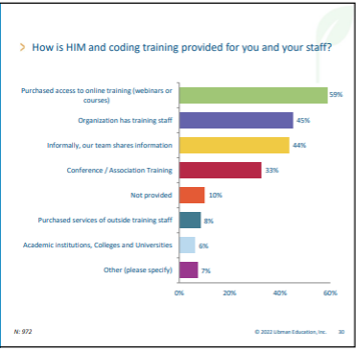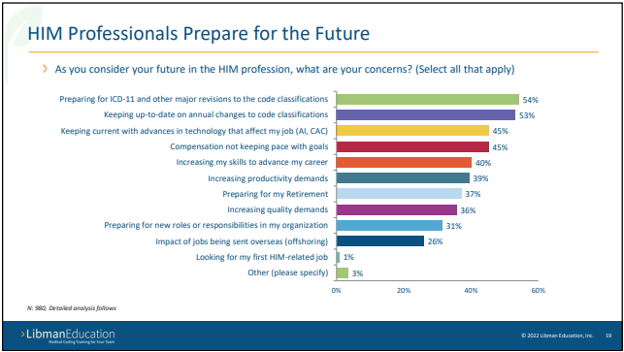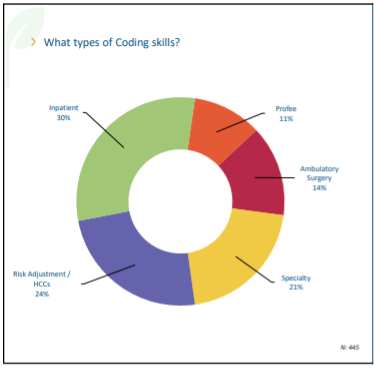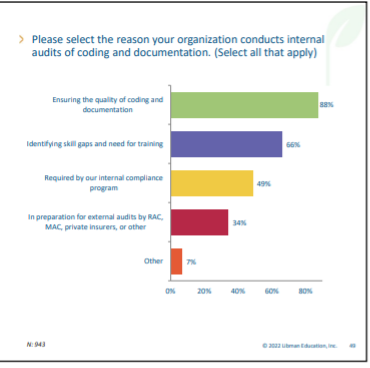E-News Exclusive |
Census Reveals How HIM Professionals Are Embracing the Opportunity to Evolve
By Angela Lima, BS, CCS, CDIP, CIC, COC
Most HIM professionals say they want to seek additional training in the coming year with plans for skills development focusing on coding, auditing, management, and clinical documentation integrity.
The only constant is change. Change is what drives us to become more enlightened. It forces us to step out of our comfort zones and into new areas of opportunity and growth. It is not always easy, but change can be very rewarding if we learn to embrace it. That is exactly what today’s forward-thinking HIM professionals are doing as technology, the pandemic, and dynamic regulations continue to shape the profession.
Libman Education’s 2022 HIM Professional Census found that most HIM professionals want to seek additional training in the coming year with plans to focus on coding (81%), auditing (58%), management (39%), and clinical documentation integrity (28%). Libman Education conducted its annual HIM Professional Census in May 2022, and more than 1,200 participants nationwide responded.
Sharpening Skills Development
Today’s in-demand HIM professionals already know that HIM is a dynamic profession with many career opportunities to consider. When you are ready for a change, you can pivot and shift gears. HIM is one of the few careers that provide that type of flexibility. See Sidebar A for ideas on steps to take as you prepare for a career change.
Sidebar A: Strategies for Making a Career Change
Not sure where to begin in terms of expanding your skills to stay current and competitive? Consider these strategies to focus your time and attention most effectively:
• Ask yourself: What is my long-term career goal? Think about what you enjoy about your current job and what interests you for the future. Then network with others working in those positions and ask them to talk about their career path. What did they do to move into that role, and how do they keep their skills current?
• Talk to your employer. What is your employer’s greatest need moving forward, and what can you do now to be able to fully prepare? Let your employer know you are ready to expand your skill set, and do not be shy about asking for their help
• Invest in reputable sources of education. Time is precious. We all have the same number of hours in a day. Make them count. Look for educational providers that have a positive reputation in the HIM community and that prioritize the learner experience.
Online training is one of the most popular methods for gaining new skills, with internal trainers and informal sharing of information among peers also used. Whatever the method, HIM professionals know they cannot stand still but instead must keep their skills sharp to respond to new opportunities and challenges. See Sidebar B for more information.
Sidebar B: Training Methods for Success
Individuals and organizations use many different training methods to ensure HIM professionals’ skills are ready for the work that needs to be done. See below for some of the most frequently cited training methods.

— Source: Libman Education’s 2022 HIM Professional Census
Staying Up to Date on Annual, Future Coding Changes
What do HIM professionals cite as their biggest concern for the future? It is a close tie between preparing for ICD-11 and other major revisions (54%) and keeping up to date on annual coding changes (53%). See Sidebar C for more information about these and other concerns participants cited.
Sidebar C: HIM Professionals Express Their Biggest Concerns for the Future
As HIM professionals look ahead, here are their concerns:

— Source: Libman Education’s 2022 HIM Professional Census
For many HIM professionals, keeping up with these changes means reaching into their own pockets to pay for education. Nearly 3 in 10 respondents say their employer does not provide them with any support for training. Although this is unfortunate, it does not absolve professionals of the responsibility to stay abreast of important industry changes. It is every HIM professional’s responsibility to master code changes and share critical information with others who need to know. For example, coders can help educate physicians who may need to provide more specific documentation. They can also help facilitate any necessary updates to the chargemaster or payer contracts.
Even though HIM professionals are concerned about the ability to stay up to date on coding changes, they are up for the challenge and do not plan to shy away from it. In fact, of those planning to seek additional coding training, the greatest interest was in coding more complex cases. See Sidebar D for more information.
Sidebar D: Coder Training Is a Top Priority
Of those planning to seek additional coding training, the greatest interest was in coding types of greater complexity. This reflects a trend toward automation and the need for a more skilled workforce. Consider the following areas in which coders hope to gain experience:

— Source: Libman Education’s 2022 HIM Professional Census
Pursuing New Career Opportunities
The pandemic continues to disrupt the coding profession with 1 in 6 respondents saying their job responsibilities have changed due to COVID-19. Whether it is adding new responsibilities, pursuing new roles, or both, coders know that evolution is necessary. Fortunately, evolution is not something that happens to us. It is something to which we contribute. We play a role and can shape our futures. Using this lens can help you grow and pursue more interesting and rewarding work.
Auditing is a natural career path for skilled coders wishing to use their knowledge in novel ways or to increase job security. It is not surprising then that 38% of respondents anticipate enhancing their auditing skills in the next year. How? Forty percent want to gain more experience in auditing a specific type of coding (eg, inpatient, outpatient, or emergency department), 35% want to gain more experience in auditing a specific aspect of coding (eg, hierarchical condition categories or diagnosis-related groups), and 21% want to gain more experience in auditing in response to a specific challenge (eg, compliance vulnerabilities or recovery audit contractor audit findings).
Auditing is a complex job that requires top notch coding skills as well as interpersonal skills and the ability to communicate clearly and concisely in both written and verbal formats. Coders are a great fit because auditing makes use of their in-depth skills and their knowledge of the organization and people within it.
The need for high-quality auditing skills has only increased over time as payer policies become more stringent and the fines, penalties, and recoupments associated with errors become steeper. Today’s health care organizations also use audits for a variety of purposes. See Sidebar E for more information.
Sidebar E: Auditing in High Demand
Today’s health care organizations use auditing for the following purposes:

— Source: Libman Education’s 2022 HIM Professional Census
Another area of career opportunity is management. The 2022 HIM Professional Census found that 30% of respondents want to increase their management skills in the next year. Among those respondents who indicate interest in new or advanced skills in management, 6 in 10 will seek general management and/or leadership skill development. The remaining 4 in 10 seek greater skills in project management.
In addition, nearly 30% of respondents want to increase their skills in data analytics (64%) and informatics (36%). HIM professionals that obtain data- and management-related skills are well-positioned to move into coding manager roles—both on the hospital and outsource vendor sides—where they would manage multiple teams of coders and be responsible for education, data reporting, and more.
A third area of career opportunity is data analytics. Nearly one-quarter of respondents anticipate needing to enhance their data analytics skills in the next year. How? Forty-two percent want to learn a specific tool or technology while 36% want general education.
Embracing New Workflows
Health care organizations continue to seek new ways of organizing the coding function to address staffing shortages, improve coding efficiency, and promote data integrity. Workflow management becomes critical. For example, 1 in 5 HIM professionals say their employer currently uses single-path coding, meaning the same coder codes the professional fee, outpatient, and, at some organizations, inpatient services. Single path coding could be one solution to labor cost containment and workforce shortages; however, it is too soon to tell whether this trend will continue.
On the contrary, many organizations continue to develop specialized workflows either by setting or service area to increase efficiency and proficiency. Coders who specialize in certain procedures, for example, know what payers expect and can proactively identify and remedy potential errors and omissions.
Here is my recommendation: Gain both a broad command of coding as well as advanced skills in one or more area. While your next job may not call for those specific advanced skills, obtaining those skills will help you prove to yourself that you can do it—and you can do it again, if needed.
Complementing Technology and Automation
Automation and artificial intelligence (AI) have already permeated the coding world, and many experts say these technologies are the way of the future. More than one-half of health care organizations (62%) already use computer-assisted coding (CAC). CAC and other AI-driven solutions are powerful tools to support the coding process, and they demand a more skilled coding workforce. That is because coders using this technology work the exceptions—the more complex cases the technology is not yet able to address. CAC and AI do not replace coders—they simply free them up to provide greater value to the revenue cycle process.
Looking Ahead
The 2022 HIM Professional Census found that coder workloads continue to increase for the second year after a sharp COVID-related decrease in 2020. The good news? Better trained coders discover the correct answer more quickly. They code more records in less time. Their coding stands up to denials and audits. Instead of facing coder burnout, they thrive in a more challenging work environment. Remember: People who constantly strive to improve their skills will always be in demand. The future will be different, but we can shape that difference if we continue to stay engaged.
Request your free copy of Libman Education’s 2022 HIM Professional Census results at https://libmaneducation.com/2022-him-professional-census/.
A Final Thought
The HIM Professional Census started as a way for Libman Education to understand our students better. Over time, the census has grown and changed. During the early days of COVID-19, it became a way to memorialize the lived experience of HIM professionals coping with the extraordinary challenges of that time. As we look forward, we will continue to capture information about the work of our fellow HIM professionals and share this information back with our readers.
Is there something you wish we would ask? We welcome your input and ideas. Contact me at Alima@LibmanEducation.com. The 2023 HIM Professional Census will be here before we know it!
— Angela Lima, BS, CCS, CDIP, CIC, COC, is director of education and training at Libman Education.



